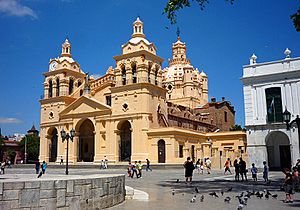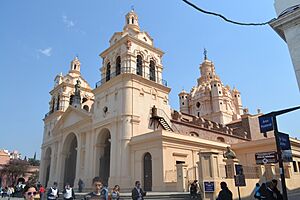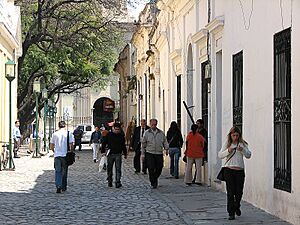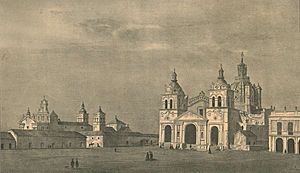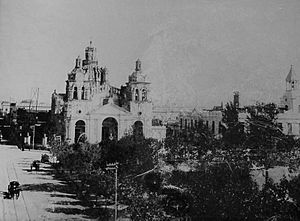Cathedral of Córdoba, Argentina facts for kids
The Cathedral of Córdoba is a very old and important church in Córdoba, Argentina. Its full name is Our Lady of the Assumption (Spanish: Nuestra Señora de la Asunción). It's the main church for the Roman Catholic community in Córdoba and is the oldest church in Argentina that has been used continuously since it was built.
This amazing building is one of Argentina's most valuable historical buildings. Because of its importance, it is a National Historic Monument. It is also close to the Jesuit Block, which is a World Heritage Site recognized by UNESCO.
Contents
Where is the Cathedral Located?
The Cathedral of Córdoba is right in the middle of the city's historic area. It faces the west side of Plaza San Martín, which used to be called Plaza Mayor.
On its north side, the church is separated from the Cabildo (an old government building) by a narrow street called Santa Catalina. The main entrance of the cathedral faces east-south-east. This is a bit unusual because many old churches were built so their main altar faced Jerusalem.
North of the cathedral, there's a small but historic square called Plazoleta del Fundador. It has a statue of Jerónimo Luis de Cabrera, who founded the city.
A Look at the Cathedral's History
Building the Cathedral of Córdoba started in 1582. It was first called the Church of Our Lady of the Assumption, which is still its name today. In 1598, builders Gregorio Ferreira and Juan Rodríguez began constructing the church using strong materials like stone, bricks, and lime.
Later, in 1601, Mateo Domínguez worked on the roof's wooden frame. Hernando Álvarez was in charge of making roof tiles. The overall design was guided by architect Ricardo González Merguete. The work really sped up thanks to architects and Jesuits (members of a Catholic religious order). Giovanni Battista Primoli designed the main layout, which looks like a Latin cross. This design was similar to the Jesuit Church of the Gesù in Rome.
The cathedral was officially opened in 1706. In 1758, a Franciscan friar named Vicente Muñoz designed and oversaw the building of the dome with its tall towers. The front of the church was designed and finished by Andrea Bianchi in 1729.
By May 18, 1758, most of the building was complete. This included the main parts of the church, the large dome, and the grand entrance with its wide staircase. The two tall bell towers were finished later, in 1787. The large entrance door and the choir seats around the main altar were made by Jesuits from special cedar wood. The clock in the tower was a gift from an English railway company in the late 1800s.
In 1901, a statue of Christ the Redeemer was placed at the very top of the front of the church. This statue was made in Paris, France.
The front entrance area of the cathedral, along with its underground rooms, became the burial place for many important people from Córdoba Province and Argentina. These include General José María Paz, Dean Gregorio Funes, and Bishop Hernando de Trejo y Sanabria, who was the first leader of the University of Córdoba.
The inside of the cathedral is very fancy. It has a silver altar made in Bolivia and a special church cabinet given in 1804. There are also many silver and gold gifts from people. In the early 1900s, artists like Emilio Caraffa painted beautiful pictures and murals on the walls and ceilings.
What Makes the Cathedral Special?
The inside of the cathedral is truly beautiful. The main central area has a high, curved ceiling that is decorated with many carved wooden designs, some covered in gold leaf. The main altar fits perfectly with the tall columns and old statues of Catholic saints. These statues are valuable artworks, and many can be moved and are dressed in rich clothing.
Sunlight shines into the church through windows high up in the curved ceiling of the main area. This central area is taller than the two side areas. Tall, golden columns separate these sections. Above the entrance, there is a large pipe organ.
The main towers have bells. The tower on the southeast side has a large clock. If you look closely at the corners of the towers, you can see interesting sculpted figures dressed in native clothes, appearing to play trumpets.
When you enter the cathedral, you step into a large entrance area. Here, you can find the tombs of important figures like José María Paz and his wife. The remains of Dean Gregorio Funes are also here. In the underground crypts, you'll find the remains of Bishop Fernando Trexo y Senabria, who was the first leader of Argentina's first university (now called the UNC). Friar Mamerto Esquiú is also buried here. On November 7, 2011, the remains of Juan Bautista Bustos were moved to the cathedral with honors.
The main altar is largely made with detailed silver from what was once Colonial Bolivia.
The dome is a very impressive part of the cathedral. It is located where the main central area crosses another section. Its large size and detailed decorations are very striking. It's an amazing dome because of how tall it is and the clever way it was built. It has four octagonal towers around it that help support it.
The dome has large windows with curved shapes. It is covered with rib-like sections that lead up to a small tower called a lantern. This lantern is decorated with pillars, small spires, and windows. The lantern is topped with a bulb-shaped dome that ends in a weather vane showing a chalice and a cross.
The entire Cathedral of Córdoba is a wonderful mix of different styles. It combines ideas from the Renaissance, Spanish colonial Baroque, Neoclassical styles, and even some Mudéjar details.
The cathedral also has a treasury filled with valuable items. These include gifts from wealthy people, like silver staffs with gold details, and crowns of silver and gold decorated with diamonds and pearls used to "dress" statues of the Virgin Mary. There's also a large cabinet for sacred items donated in 1804, and fancy silk shawls. Sadly, some of the cathedral's treasures were stolen in the late 1900s.
Gallery
-
Tomb of Gen. José María Paz
-
Tomb of Dean Gregorio Funes
See also
 In Spanish: Catedral de Nuestra Señora de la Asunción (Córdoba) para niños
In Spanish: Catedral de Nuestra Señora de la Asunción (Córdoba) para niños
- List of tallest structures built before the 20th century


